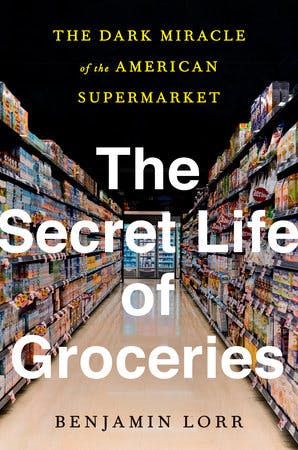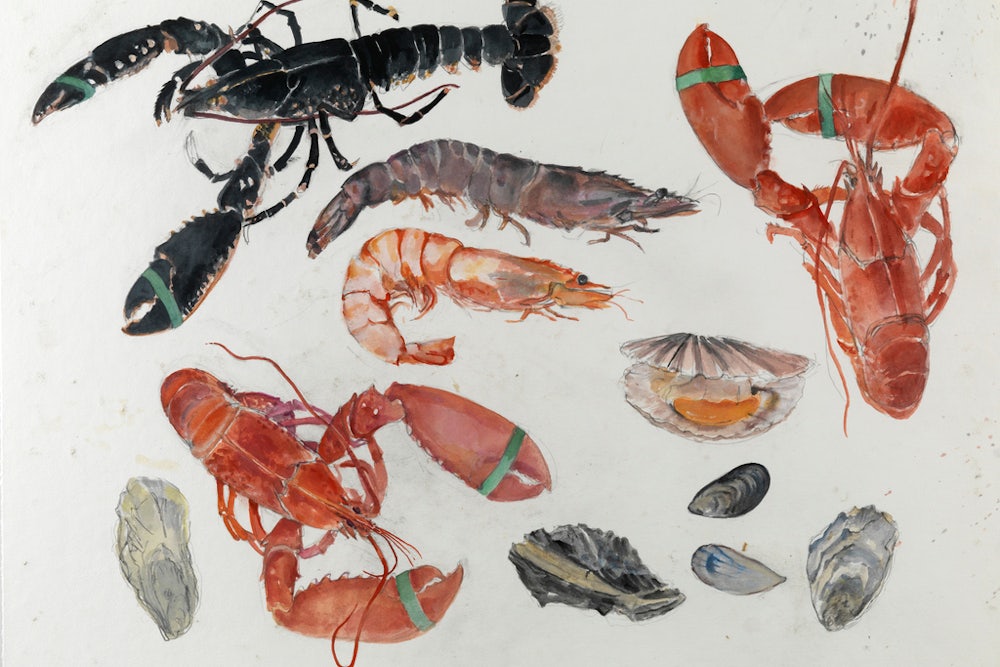Of all the edible creatures in the sea, America’s favorite is the shrimp. We gorge upon their flesh to the tune of 4.4 pounds per person per year. Accordingly, the business of shrimp is oceanic: In 2017, the amount of shrimp imported to the United States grew to 1.5 billion pounds, representing over 1 percent of the nation’s entire foreign trade deficit.
Shrimp are perhaps the paradigmatic grocery store item. They used to be expensive, and now they’re not. They are born animals, and when they die they become meat, then cargo, then merchandise represented by a bar code—a product with a notably high profit yield on the grocery floor because it’s a dirt-cheap factory-farmed import.
As Benjamin Lorr notes in his horrifying new book, The Secret Life of Groceries, the “fishmonger” at stores like Whole Foods only exists as window dressing, designed to lure the fish-loving customer to the actually profitable frozen shrimp in the freezers nearby. This kind of casting is true, Lorr explains, of nearly all supermarket employees, who would be automated away in a heartbeat if the data didn’t show that the average American consumer prefers a human touch.
Unfortunately, the shrimp imported into the U.S. food supply are farmed using slave labor. That’s not really a disputable fact: In 2018, the National Oceanic and Atmospheric Administration found that shrimp imported from countries with “poor regulations,” like Thailand, had 92 percent of the U.S. market share. According to the relevant NGOs, “17 to 60 percent” of Thai shrimp includes slave labor at some stage in its supply chain. That might sound “like a wildly high error range,” Lorr observes, “but nobody knows anything in this world.”
None of this is news. The Guardian broke the story on Thai shrimp industry slave labor five years ago. And yet nothing happened, with the shrimp business in fact continuing to boom further. This is because the entire supply chain putting food in our supermarkets has been whittled down to the sharpest edge of profitability by suit-wearing Midwesterners who pride themselves on exemplifying the American capitalist spirit. It’s more surprising that anybody put the Thai shrimp industry story on a newspaper front page, Lorr thinks, than it is that we’re eating the fruits of indentured labor.
It’s worth reproducing in full what Margie Mason of the Associated Press told Lorr about Whole Foods’ reaction to her Pulitzer-winning reporting on child labor in the Thai shrimp industry, because it demonstrates the gulf between the way Whole Foods must present itself in public and the way it is actually run:
When our story came out … Whole Foods was calling us and pleading, saying none of the shrimp from that plant got into their supply chain. And we were just baffled. “How can you be sure? We are the people who informed your supplier! Are you saying you have closer oversight of your supplier’s supply chain than they do? If so, how? Your exporter had no idea. Your importer had no idea. So how can you be so sure?” But they just kept pleading and pleading. It was crazy making.
Determined to find some certainty at the other end of the supply chain, Lorr goes on a reporting mission to Thailand, where he meets and profiles a laborer from Myanmar named Tun-Lin. He had no idea what he was signing up for when a recruiter approached him in Samut Sakhon and then kept him locked up with 25 other men in a room with no mattresses in it. He’s lost a hand, and years of his life, but considers himself lucky.

Through the story of Tun-Lin’s career, Lorr proves that there’s no way for a grocery store buyer to trace the origin of all the shrimp they’re stocking because the chain of supply is fractured into nonsense. “Shrimp are raised everywhere,” Lorr writes, “shipped to new, more specialized facilities at each stage, combined with others, then separated back out. The concept of traceability barely makes sense.” Tun-Lin himself barely had any idea where he was when he was working on the boats.
Fortunately for those making money off the whole enterprise, dead shrimp can tell no tales. Lorr’s book is about precisely this kind of half-known horror, and his barely exhaustive investigation into shrimp hits a bull’s-eye of moral hypocrisy in American society. The Secret Life of Groceries answers a question many have wanted to know over the last few years in general, and in the last few months with increasing urgency: Is there any truly ethical way to buy groceries in America?
In short: no. Americans now spend only 10 percent of their budgets on food, Lorr notes, while in 1900 it was 40 percent. Our food is the cheapest in the world because we import so much of it from places where things like labor and antibiotics are cheap. Not only that, we hunger for cheapness in our own shopping habits, forever seeking the great promotional deal. Grocery executives, in Lorr’s felicitous phrase, “hunger for our hunger.” We know all this is too good to be true, which is why entire franchises are devoted to putting our minds at ease.
It’s all been researched to death. Trader Joe’s still makes huge money from its image as a quirky chain that pays its workers well, because that’s what appeals to thrifty overeducated people who identify with their products. That’s despite the fact that Trader Joe’s is owned by Aldi conglomerate Albrecht Discounts and parted ways long ago with its founder, Joe Coulombe, whom Lorr profiles at length. Albrecht Discounts kept the brand, which strongly implies some kind of down-home reasonableness and moral fiber but has none of Coulombe’s values.
No label is to be trusted. But we choose the “organic”-labeled shrimp or the “free range” eggs anyway, because what’s the alternative? Buy the eggs without the cage-free label and you may as well be deliberately upholding chicken suffering. “Organic” might signify zero about the shrimp’s farmed origins, but it’s a gesture of hope. Gradually, you forget about that story you read in The Guardian, and you’re eating shrimp again. Maybe you just went over to look through the fishmonger’s window; things just have a way of jumping into your basket.
Simon Baker, a migrant researcher, tells Lorr that boycotting a single product is pointless. “Look at what happens when abused children get pushed out of labor markets. They typically don’t suddenly find better jobs. They get pushed further underground,” he says. “What you in the West have to realize is the entire narrative is backwards. In trafficking, the media focuses on why and where poor people get into difficult situations. But maybe we should be looking at why they are poor to begin with?”
The answer is, of course, the “hunger behind our hunger.”
Between the production sites of our goods and the supermarkets lie the roads. One of Lorr’s most affecting investigations follows Lynne, one of only 5 percent of American truckers who are women, as she staves off the financial devastation that confronts so many in her industry. Back when truckers had champions in (corrupt) union men like Jimmy Hoffa, driving was a solid job, even inspiring a cheerful handful of movies in the 1970s, like Smokey and the Bandit. It remains the circulatory system of America’s domestic economy since, as Lorr writes, “everything—everything—in your life comes to you on a truck.” Nearly 13 million commercial drivers crisscross America’s roads, but the job is nothing like it used to be.
Lynne is very good at her job, and she is also “homeless, sleeping exclusively in the cab of a truck she does not yet own and almost certainly will eventually lose.… Her credit is shot. She has outstanding vet bills for her two dogs, the closest and most beloved members of her family. Her personal health is so wrecked, it’s hard to even discuss.” She just can’t earn enough to keep up with her payments.
Meanwhile, truckers usually train in assigned pairs, and sexual assault is common for women trainees. Lynne is over six feet tall, burly, and tells Lorr she would never walk between two trucks at night at a rest stop. Male truckers assaulted an acquaintance of hers underneath a trailer. “There is four feet of clearance under there. Nobody heard her scream. She crawled back to her truck and I was the first person she called. I was two hundred miles away.” They weren’t even friends.
Lynne is talented at and loves her job and is suffering from terrible deprivation—facts that are, in Lorr’s view, related. “There are some jobs,” he writes, “where it is almost impossible to succeed because they are very difficult. Then there are jobs where you are designed to fail.” The trucking-on-demand, lease-to-own systems that now dominate American transit systems are both. Lorr reports on “trucking recruiters who cruise for drivers from homeless shelters, soup kitchens, recovery wards, prison work-release programs. Many more come from minimum wage retail, from construction, from several tours of duty overseas.” These recruiters make promises: “‘Guaranteed jobs!’ ‘No experience? No problem!’ ‘Get paid while training’ ‘Fantastic money!’” What candidates actually get is a free one-way bus ticket to a training center and a huge initial debt to the recruiter that they will inevitably struggle to pay off.
Trucking is now an industry thriving on its workers’ vulnerability, in ways eerily reminiscent of Tun-Lin’s life story. The details in Lynne’s story are maddeningly poignant. For example, this linchpin in the distribution of agricultural goods credits the smartphone app Farm Town—a simulation of an agrarian economy, which she plays from the cab of her truck at rest stops—with maintaining her sanity. “I thank God,” she says, “for Farm Town.”
You have no choice. You can shop at a store that pays its workers better, sure, but the real atrocities have taken place long before your desired products have reached the shelf, and the stickers have nothing to do with it. “And here grocery has one last trick,” Lorr writes: “it allows us to hate our shrimp and eat it too. The image of the bad polluting aquaculture farmer or vulnerable exploited migrant gets imprinted in our first-world brain, while the fungibility of commodity goods—that maze of brokers and agents—gives the entire system the plausible deniability it craves.”
So what do you do? I have no idea. Personally, I react to the impossibility of doing no harm while shopping with a disordered impulsivity. Terrified of the grocery stores, I forage at my local bodega, eating the mark-up like a deserved punishment while probably engaging completely equivalent supply chains. I’m tipping wildly, but only because it helps me disburden myself of the feelings associated with what I know about grocery stores. I play out a kind of theater of generosity in the tiny movie set of my everyday life, because, for all the bullshit that comes with working at an American grocery store, the real problem with groceries is that nobody at my end of the supply chain is being exploited at the level people are at the beginning or the middle.
In the Covid-19 era, where delivery rules all, supply chains have been laid bare in a way that storefront commerce usually camouflages. You can reluctantly risk exposure to the virus at the supermarket or employ some kind of vendor to deliver food to your house. The storefront theater thus has fewer opportunities to distract us with prop fishmongers. The decisions are more obvious, their implications starker. Ultimately, grocery shopping is the least avoidable and one of the most ethically compromised activities in our lives. The least we can do, Lorr suggests, is know something about it.
